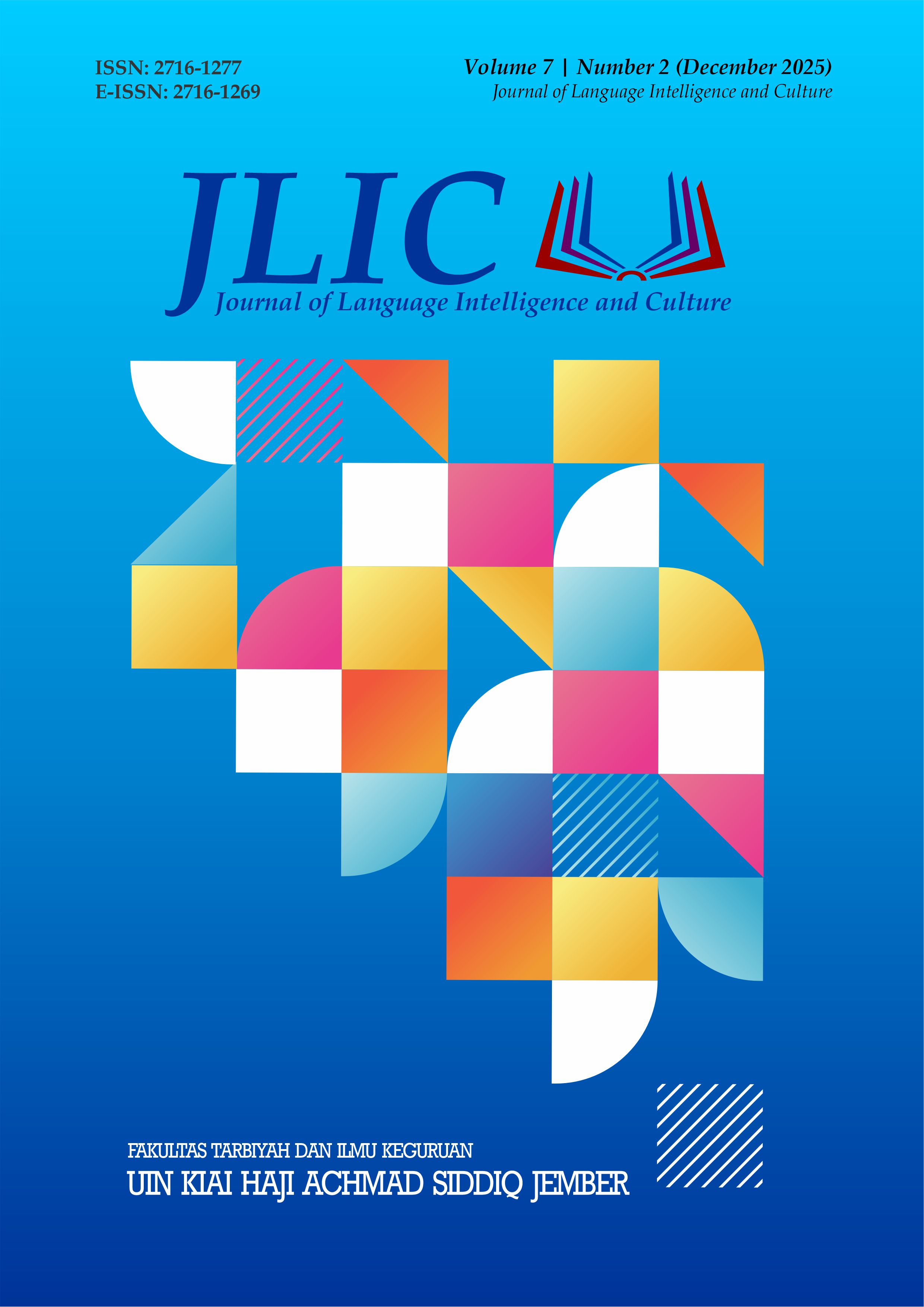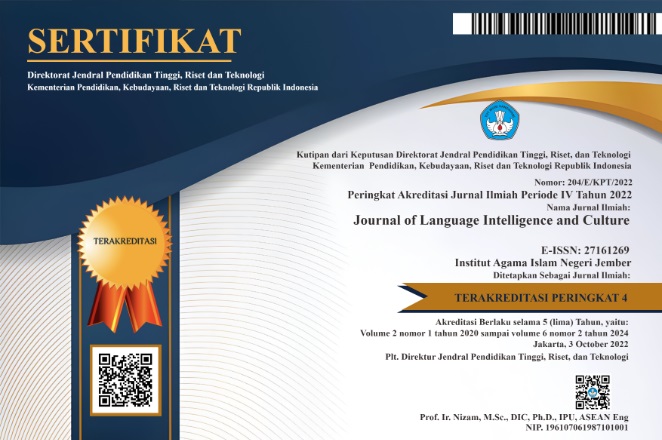Bridging Ideas: How Mind Mapping Enhances Dialogic Collaborative Learning Outcomes
DOI:
https://doi.org/10.35719/jlic.v7i2.642Keywords:
Mind mapping, dialogic collaborative learning, learning outcomesAbstract
Mind Mapping has gained recognition as a visual learning strategy that enhances comprehension and engagement. Yet, its application in dialogic collaborative learning within English Language Education remains underexplored. This study explores students’ perceptions of Mind Mapping as a collaborative learning tool, highlighting its pedagogical potential and challenges in higher education. Conducted at Antasari State Islamic University Banjarmasin, the research involved six English Language Education students from the 2022 cohort. Data were gathered through in-depth semi-structured interviews and analyzed using Miles and Huberman’s Interactive Model to identify key themes. Findings reveal that students view Mind Mapping as a productive tool that simplifies complex material, promotes dialogic interaction, and fosters creativity and critical thinking through deeper content engagement. However, three main challenges emerged: (1) differing preferences for digital versus manual mapping, (2) unequal participation among group members, and (3) excessive focus on visual aesthetics over content depth. The study concludes that effective integration of Mind Mapping in collaborative learning requires teacher facilitation, explicit guidance, and a balanced emphasis on both form and meaning. These insights contribute to research on collaborative learning in English Language Education and offer practical implications for educators seeking to incorporate visual tools in EFL contexts.
References
Adodo. (2013). Effect of Mind Mapping as a Self-Regulated Learning Strategy on Students ’ Achievement in Basic Science and Technology. Mediterranean Journal of Social Sciences, 4(6). https://doi.org/10.5901/mjss.2013.v4n6p163
Aprinawati, I. (2018). Penggunaan Model Peta Pikiran (Mind Mapping) Untuk Meningkatkan Pemahaman Membaca Wacana Siswa Sekolah Dasar. Jurnal Basicedu, 2(23).
Arulselvi, E. (2017). Mind Maps in Classroom Teaching and Learning. Excellence in Education Journal, 6(2).
Ary, D., Jacob, L. C., & Sorensen, C. (2010). Introduction to Research in Education (8th ed.).
Astriani, D. (2020). Mind Mapping in Learning Models : A Tool to Improve Student Metacognitive Skills. IJET, 15(6), 4–17. https://doi.org/https://doi.org/10.3991/ijet.v15i06.12657
Barkhuizen, G. (2014). Revisiting narrative frames: An instrument for investigating language teaching and learning. System, 47, 12-27. https://doi.org/10.1016/j.system.2014.09.014
Braun, V., & Clarke, V. (2013). Successful Qualitative Research A Practical Guide For Beginners.
Burgess-Allen, J., & Owen-Smith, V. (2010). Using Mind Mapping techniques for rapid qualitative data analysis in public participation processes. Health Expectations, 13(4).
Buzan, T. (2006). The Mind Map Book: Unlock Your Creativity, Boost Your Memory, Change Your Life. BBC Active.
Cahyanti, A. D., Sudibyo, E., & Rahayu, Y. S. (2021). Effectiveness of insect encyclopedia e-book with Mind Mapping strategy to train students' creative thinking skills. IJORER: International Journal of Recent Educational Research, 2(4). DOI: https://doi.org/10.46245/ijorer.v2i4.131
Clandinin, D. J., & Caine, V. (2013). Narrative inquiry. In Reviewing qualitative research in the social sciences (pp. 166-179). Routledge. https://www.taylorfrancis.com/chapters/edit/10.4324/978020381332417/narrative-inquiry-jean-clandinin-vera-caine
Creswell, J. . and, & Creswell, J. D. (2018). Research Design Qualitative, Quantitative, and Mixed Methods Approaches Fifth Edition.
Creswell, J. W. (2009). Research Design Qualitative, Quantitative, and Mixed Method Approaches.
Crowe, M., & Sheppard, L. (2012). Mind Mapping research methods. 46:1493–1504. https://doi.org/10.1007/s11135-011-9463-8
Cui, R., & Teo, P. (2021). Dialogic education for classroom teaching: A critical review. Language and education, 35(3). https://doi.org/10.1080/09500782.2020.1837859
Halim, A. (2022). Facilitating EFL Students in Maintaining Flow of Talks Using Mind Mapping. 8(1), 59–71.
Harrison, S., & Gibbons, C. (2013). Nursing student perceptions of concept maps: From theory to practice. Nursing Education Perspectives, 34(6), 395-399. doi: 10.5480/10-465
Hidayati, R. (2022). English Students’ Perceptions Of The Use Of Mind Mapping Technique To Improve Their Speaking Ability. Universitas Islam Negeri Ar-Raniry Banda Aceh.
Husni, M. (2018). Memahami konsep pemikiran mind map tony buzan (1970) dalam realitas kehidupan belajar anak. Al-Ibrah: Jurnal Pendidikan dan Keilmuan Islam, 3(1).
Husniati, S. (2020). Use the Mind Mapping Note Taking Method as a Creative Learning Tool. Rumie Bytes. Retrieved from https://learn.rumie.org/jR/bytes/need-a-more-creative-way-to-study-use-the-mind-mapping-note-taking-method/
Jay, T., Willis, B., Thomas, P., Taylor, R., Burnett, C., Merchant, G., & Stevens, A. (2017). Dialogic Teaching Independent evaluators : July.
Kim, M. (2008). Dialogic concept mapping in the zone of proximal development.
Kim, M., & Wilkinson, I. A. G. (2019). Learning , Culture and Social Interaction What is dialogic teaching ? Constructing , deconstructing , and reconstructing a pedagogy of classroom talk. Learning, Culture and Social Interaction, 21(July 2018), 70–86. https://doi.org/10.1016/j.lcsi.2019.02.003
Kumar, S. (2018). Quality Enrichment On Teaching Competency Through Mind Mapping Strategies. Journal Of Innovation In Education & Psychology, No. 6(2).
Luangkrajang, M. S. (2022). Use of Mind Mapping in language learning: A cognitive approach. Theory and Practice in Language Studies, 12(8). DOI: https://doi.org/10.17507/tpls.1208.18
Machado, C. T., & Carvalho, A. A. (2020). Concept mapping: Benefits and challenges in higher education. The Journal of Continuing Higher Education, 68(1). https://doi.org/10.1080/07377363.2020.1712579
Manalo, E. (2020). Deeper Learning, Dialogic Learning, And Critical Thinking.
Meirbekov, А. К. (2022). Using the “mind map” method in the development of students’ vocabulary in English. Bulletin of the Karaganda university Pedagogy series, 107(3). https://doi.org/10.31489/2022ped3/122-127
Miles, M. B., Huberman, A. M., & Saldaña, J. (2014). Qualitative Data Analysis (3rd ed.).
Muhib, A., B, D. A. L., & Hartono, R. (2014). Mind Mapping And Everybody Writes Techniques For Students With High. 4(2), 99–105.
Mustaji. (2015). Pemberdayaan Mahasiswa untuk Berfikir Kritis, Kreatif, dan Kolaboratif melalui Pengembangan Perangkat Pembelajaran Kolaborasi. Kwangsan, 3(1). https://doi.org/10.31800/jtp.kw.v3n1.p59--76
Novita, D., Kurnia, F. D., & Mustofa, A. (2020). Collaborative Learning As The Manifestation Of Sociocultural Theory : Teachers ’ Perspectives. 9(May).
Patton, M. Q. (2002). Qualitative Research Evaluation Methods (3rd ed.).
Pennebaker, J. . (2017). Mind Mapping : Using everyday language to explore social & psychological processes. Procedia Computer Science, 118, 100–107. https://doi.org/10.1016/j.procs.2017.11.150
Polat, O., Sezer, T., & Akyol, N. A. (2022). Collaborative Learning with Mind Mapping in the Development of Social Skills of Children Özgül Polat Türker Sezer. Participatory Educational Research (PER), 9(January). https://doi.org/http://dx.doi.org/10.17275/per.22.25.9.1
Polkinghorne, D. E. (1995). Narrative configuration in qualitative analysis. International Journal of Qualitative Studies in Education, 8(1), 5–23. https://doi.org/10.1080/0951839950080103
Redhana, I. W. R., Widiastari, K., Samsudin, A., & Irwanto. (2021). Which Is More Effective, A Mind Map Or A Concept Map Learning Strategy? I. 40(2). https://doi.org/10.21831/cp.v40i2.33031
Riessman, C. K. (2008). Narrative methods for the human sciences. Sage Publications.
Ruiguo Cui & Peter Teo (2020): Dialogic education for classroom teaching: critical review, Language and Education, https://doi.org/10.1080/09500782.2020.1837859
Sayrs, L. (2019). InterViews : An Introduction to Qualitative Research Interviews : An Introduction to Qualitative Research Interviewing by Steinar Kvale . Thousand Oaks , CA : Sage , 1996 . 326 pp . August 1998. https://doi.org/10.1016/S1098-2140(99)80208-2
Şeyihoğlu, A., & Kartal, A. (2010). The Views of the Teachers about the Mind Mapping technique in the Elementary Life Science and Social Studies lessons Based on the Constructivist Method. 10(3).
Sukardi, R. H., & Turhan, M. (2025). Penggunaan Metode Mind Mapping dalam Meningkatkan Pemahaman Konsep dan Retensi Belajar Siswa: Kajian Literatur. Didaktika: Jurnal Kependidikan, 14(1 Februari). https://jurnaldidaktika.org
Wheeldon, J., & Faubert, J. (2009). Framing Experience : Concept Maps , Mind Maps , and Data Collection in Qualitative Research. International Journal of Qualitative Methods, 8(3), 68–83.
Wijaya, K. F. (2021). Journal of English Teaching. 7, 118–132.
Wong, R. M. (2021). Collaborative Concept Mapping – Meta-Analysis And Empirical Study. July.
Downloads
Published
How to Cite
Issue
Section
License
Copyright (c) 2025 Hidayah Nor, Erma Sarita, Puji Sri Rahayu

This work is licensed under a Creative Commons Attribution-ShareAlike 4.0 International License.













